International Business: Oxfam's Strategy, HRM, and Performance
VerifiedAdded on 2023/04/05
|24
|4802
|311
Case Study
AI Summary
This case study delves into Oxfam's international business strategy within the not-for-profit charity sector. It examines the organization's pursuit of a transnational strategy, balancing global integration with local responsiveness, and the challenges encountered in achieving its strategic objectives. The analysis covers Oxfam's business model, assessing its suitability and potential for adoption by other organizations in the sector. Performance indicators, both financial and non-financial, are identified and analyzed over a four-year period to evaluate the success of Oxfam's strategy against sector benchmarks. Furthermore, the study explores Oxfam's human resources management approach, its alignment with the business model, and its contribution to the overall international strategy. The solution draws upon theoretical concepts such as social exchange theory, transnational solution theory, and transaction cost theory to provide a comprehensive understanding of Oxfam's international operations.

0
Running head: INTERNATIONAL BUSINESS & NOT FOR PROFIT CHARITY SECTOR
INTERNATIONAL BUSINESS & NOT FOR PROFIT CHARITY SECTOR
Name of the Student
Name of the University
Author’s Note
Running head: INTERNATIONAL BUSINESS & NOT FOR PROFIT CHARITY SECTOR
INTERNATIONAL BUSINESS & NOT FOR PROFIT CHARITY SECTOR
Name of the Student
Name of the University
Author’s Note
Paraphrase This Document
Need a fresh take? Get an instant paraphrase of this document with our AI Paraphraser

1INTERNATIONAL BUSINESS & NOT FOR PROFIT CHARITY SECTOR
Table of Contents
1. With reference to Oxfam and the Not for Profit Charity sector provide one example which
clearly illustrates ‘a link’ between two theoretical concepts drawn from two distinct pre-
requisites or previous modules that you have undertaken...............................................................2
2. What international strategy is Oxfam pursuing and what particular challenges have they faced
in addressing their global strategic objectives? How successful have they been in overcoming
these challenges?...........................................................................................................................12
3. With reference to Oxfam’s Business Model does this strategy make sense for Oxfam and is it
capable of being adopted by other players in the sector?..............................................................15
4. Through your research into Oxfam, identify appropriate performance indicators to illustrate
Oxfam’s financial and non-financial performance. Undertake a performance analysis of Oxfam
over the last four years. What does the analysis tell you about the success or otherwise of the
strategy adopted by Oxfam and how does it compare with sector benchmarks?..........................17
5. From a Human Resources Management perspective how would you characterize the strategy
pursued by Oxfam? To what extent does this appear to be driven by their business model and
how well does it fit and support their international strategy?........................................................19
References......................................................................................................................................21
Table of Contents
1. With reference to Oxfam and the Not for Profit Charity sector provide one example which
clearly illustrates ‘a link’ between two theoretical concepts drawn from two distinct pre-
requisites or previous modules that you have undertaken...............................................................2
2. What international strategy is Oxfam pursuing and what particular challenges have they faced
in addressing their global strategic objectives? How successful have they been in overcoming
these challenges?...........................................................................................................................12
3. With reference to Oxfam’s Business Model does this strategy make sense for Oxfam and is it
capable of being adopted by other players in the sector?..............................................................15
4. Through your research into Oxfam, identify appropriate performance indicators to illustrate
Oxfam’s financial and non-financial performance. Undertake a performance analysis of Oxfam
over the last four years. What does the analysis tell you about the success or otherwise of the
strategy adopted by Oxfam and how does it compare with sector benchmarks?..........................17
5. From a Human Resources Management perspective how would you characterize the strategy
pursued by Oxfam? To what extent does this appear to be driven by their business model and
how well does it fit and support their international strategy?........................................................19
References......................................................................................................................................21
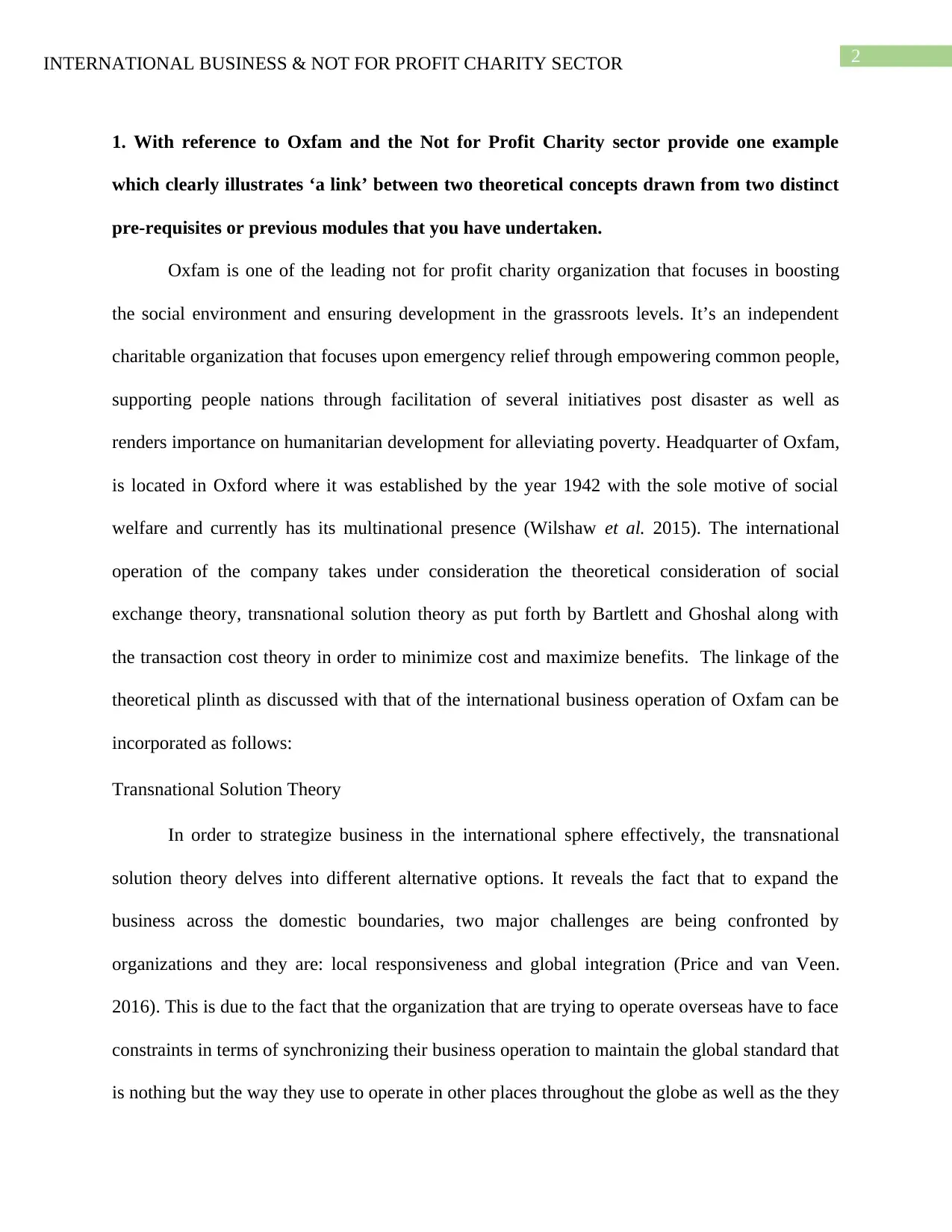
2INTERNATIONAL BUSINESS & NOT FOR PROFIT CHARITY SECTOR
1. With reference to Oxfam and the Not for Profit Charity sector provide one example
which clearly illustrates ‘a link’ between two theoretical concepts drawn from two distinct
pre-requisites or previous modules that you have undertaken.
Oxfam is one of the leading not for profit charity organization that focuses in boosting
the social environment and ensuring development in the grassroots levels. It’s an independent
charitable organization that focuses upon emergency relief through empowering common people,
supporting people nations through facilitation of several initiatives post disaster as well as
renders importance on humanitarian development for alleviating poverty. Headquarter of Oxfam,
is located in Oxford where it was established by the year 1942 with the sole motive of social
welfare and currently has its multinational presence (Wilshaw et al. 2015). The international
operation of the company takes under consideration the theoretical consideration of social
exchange theory, transnational solution theory as put forth by Bartlett and Ghoshal along with
the transaction cost theory in order to minimize cost and maximize benefits. The linkage of the
theoretical plinth as discussed with that of the international business operation of Oxfam can be
incorporated as follows:
Transnational Solution Theory
In order to strategize business in the international sphere effectively, the transnational
solution theory delves into different alternative options. It reveals the fact that to expand the
business across the domestic boundaries, two major challenges are being confronted by
organizations and they are: local responsiveness and global integration (Price and van Veen.
2016). This is due to the fact that the organization that are trying to operate overseas have to face
constraints in terms of synchronizing their business operation to maintain the global standard that
is nothing but the way they use to operate in other places throughout the globe as well as the they
1. With reference to Oxfam and the Not for Profit Charity sector provide one example
which clearly illustrates ‘a link’ between two theoretical concepts drawn from two distinct
pre-requisites or previous modules that you have undertaken.
Oxfam is one of the leading not for profit charity organization that focuses in boosting
the social environment and ensuring development in the grassroots levels. It’s an independent
charitable organization that focuses upon emergency relief through empowering common people,
supporting people nations through facilitation of several initiatives post disaster as well as
renders importance on humanitarian development for alleviating poverty. Headquarter of Oxfam,
is located in Oxford where it was established by the year 1942 with the sole motive of social
welfare and currently has its multinational presence (Wilshaw et al. 2015). The international
operation of the company takes under consideration the theoretical consideration of social
exchange theory, transnational solution theory as put forth by Bartlett and Ghoshal along with
the transaction cost theory in order to minimize cost and maximize benefits. The linkage of the
theoretical plinth as discussed with that of the international business operation of Oxfam can be
incorporated as follows:
Transnational Solution Theory
In order to strategize business in the international sphere effectively, the transnational
solution theory delves into different alternative options. It reveals the fact that to expand the
business across the domestic boundaries, two major challenges are being confronted by
organizations and they are: local responsiveness and global integration (Price and van Veen.
2016). This is due to the fact that the organization that are trying to operate overseas have to face
constraints in terms of synchronizing their business operation to maintain the global standard that
is nothing but the way they use to operate in other places throughout the globe as well as the they
⊘ This is a preview!⊘
Do you want full access?
Subscribe today to unlock all pages.

Trusted by 1+ million students worldwide
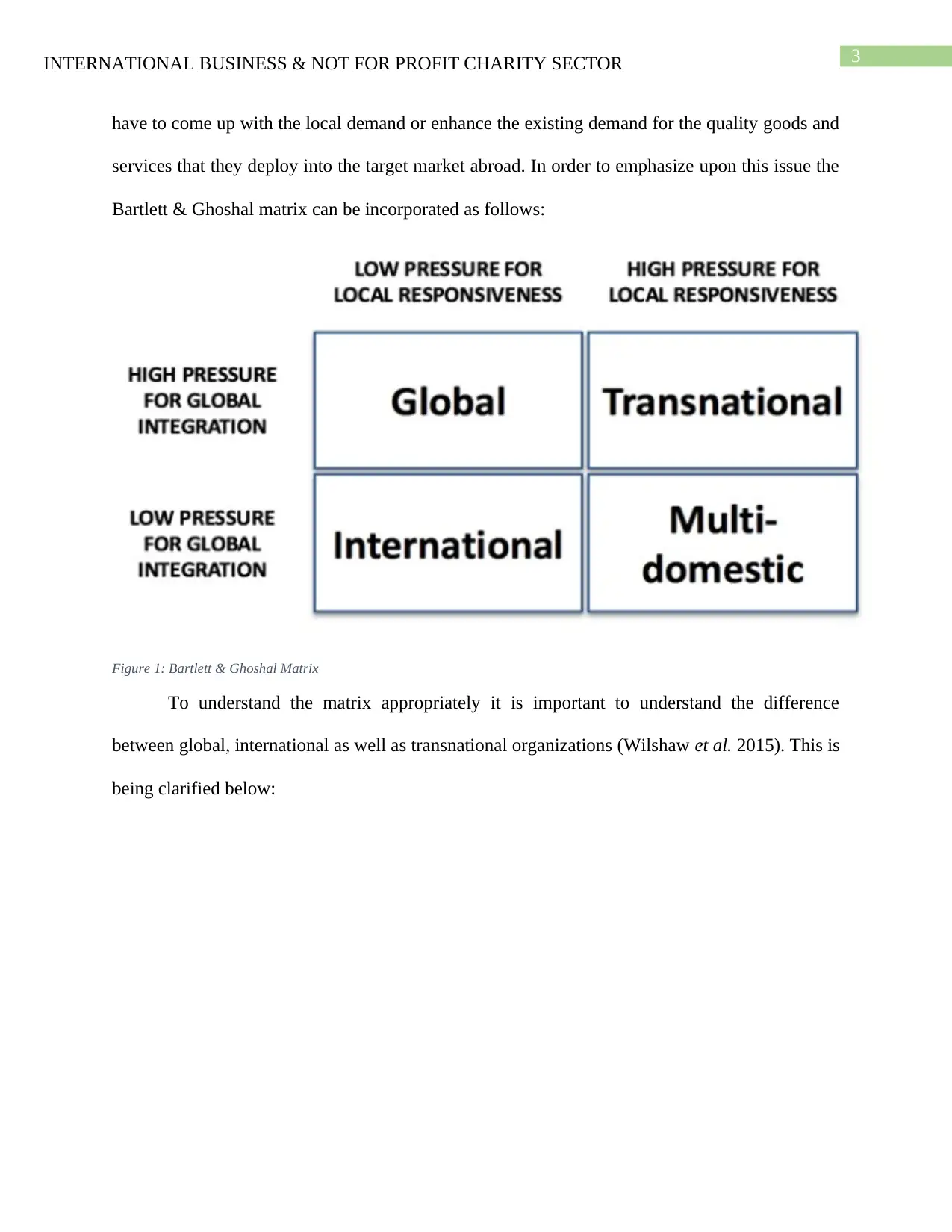
3INTERNATIONAL BUSINESS & NOT FOR PROFIT CHARITY SECTOR
have to come up with the local demand or enhance the existing demand for the quality goods and
services that they deploy into the target market abroad. In order to emphasize upon this issue the
Bartlett & Ghoshal matrix can be incorporated as follows:
Figure 1: Bartlett & Ghoshal Matrix
To understand the matrix appropriately it is important to understand the difference
between global, international as well as transnational organizations (Wilshaw et al. 2015). This is
being clarified below:
have to come up with the local demand or enhance the existing demand for the quality goods and
services that they deploy into the target market abroad. In order to emphasize upon this issue the
Bartlett & Ghoshal matrix can be incorporated as follows:
Figure 1: Bartlett & Ghoshal Matrix
To understand the matrix appropriately it is important to understand the difference
between global, international as well as transnational organizations (Wilshaw et al. 2015). This is
being clarified below:
Paraphrase This Document
Need a fresh take? Get an instant paraphrase of this document with our AI Paraphraser
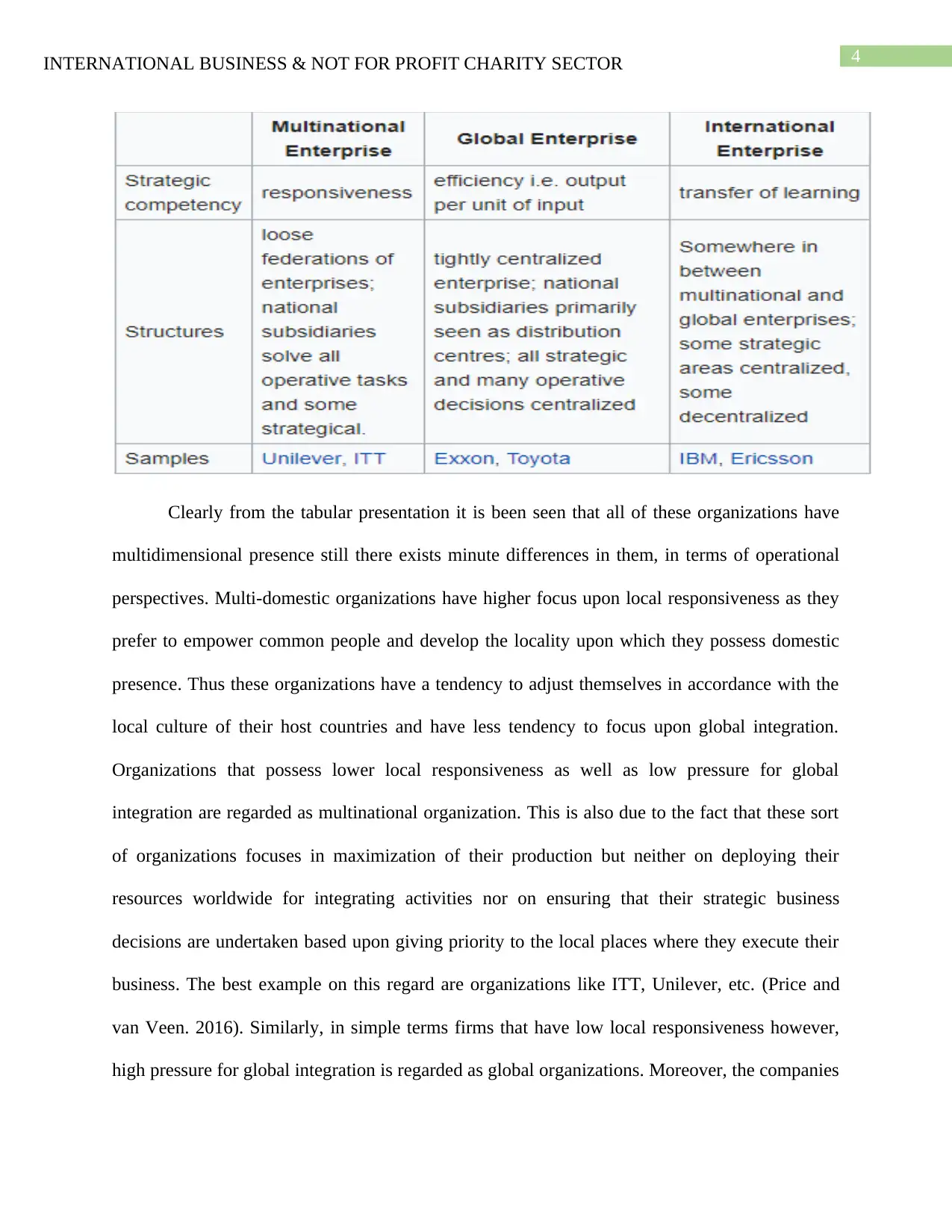
4INTERNATIONAL BUSINESS & NOT FOR PROFIT CHARITY SECTOR
Clearly from the tabular presentation it is been seen that all of these organizations have
multidimensional presence still there exists minute differences in them, in terms of operational
perspectives. Multi-domestic organizations have higher focus upon local responsiveness as they
prefer to empower common people and develop the locality upon which they possess domestic
presence. Thus these organizations have a tendency to adjust themselves in accordance with the
local culture of their host countries and have less tendency to focus upon global integration.
Organizations that possess lower local responsiveness as well as low pressure for global
integration are regarded as multinational organization. This is also due to the fact that these sort
of organizations focuses in maximization of their production but neither on deploying their
resources worldwide for integrating activities nor on ensuring that their strategic business
decisions are undertaken based upon giving priority to the local places where they execute their
business. The best example on this regard are organizations like ITT, Unilever, etc. (Price and
van Veen. 2016). Similarly, in simple terms firms that have low local responsiveness however,
high pressure for global integration is regarded as global organizations. Moreover, the companies
Clearly from the tabular presentation it is been seen that all of these organizations have
multidimensional presence still there exists minute differences in them, in terms of operational
perspectives. Multi-domestic organizations have higher focus upon local responsiveness as they
prefer to empower common people and develop the locality upon which they possess domestic
presence. Thus these organizations have a tendency to adjust themselves in accordance with the
local culture of their host countries and have less tendency to focus upon global integration.
Organizations that possess lower local responsiveness as well as low pressure for global
integration are regarded as multinational organization. This is also due to the fact that these sort
of organizations focuses in maximization of their production but neither on deploying their
resources worldwide for integrating activities nor on ensuring that their strategic business
decisions are undertaken based upon giving priority to the local places where they execute their
business. The best example on this regard are organizations like ITT, Unilever, etc. (Price and
van Veen. 2016). Similarly, in simple terms firms that have low local responsiveness however,
high pressure for global integration is regarded as global organizations. Moreover, the companies
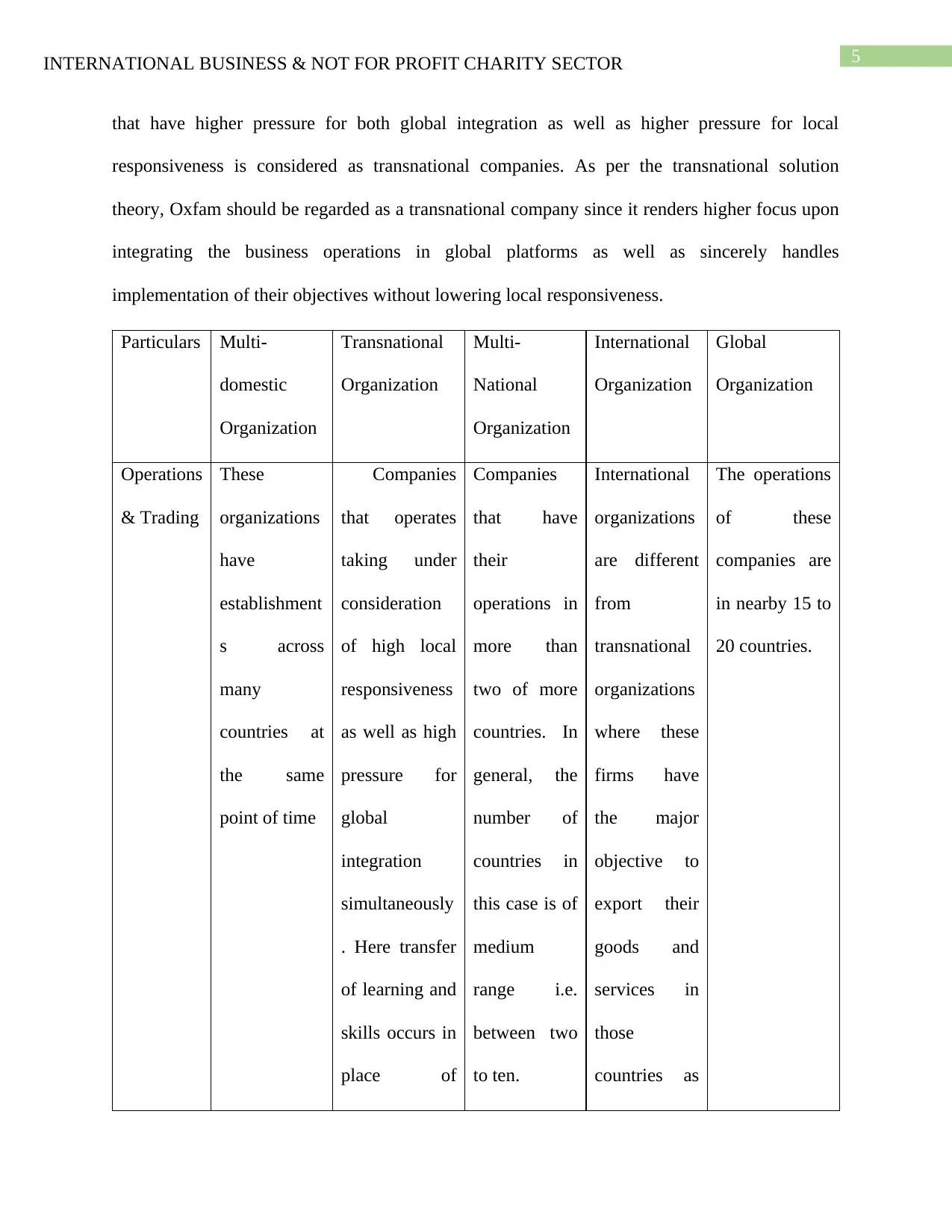
5INTERNATIONAL BUSINESS & NOT FOR PROFIT CHARITY SECTOR
that have higher pressure for both global integration as well as higher pressure for local
responsiveness is considered as transnational companies. As per the transnational solution
theory, Oxfam should be regarded as a transnational company since it renders higher focus upon
integrating the business operations in global platforms as well as sincerely handles
implementation of their objectives without lowering local responsiveness.
Particulars Multi-
domestic
Organization
Transnational
Organization
Multi-
National
Organization
International
Organization
Global
Organization
Operations
& Trading
These
organizations
have
establishment
s across
many
countries at
the same
point of time
Companies
that operates
taking under
consideration
of high local
responsiveness
as well as high
pressure for
global
integration
simultaneously
. Here transfer
of learning and
skills occurs in
place of
Companies
that have
their
operations in
more than
two of more
countries. In
general, the
number of
countries in
this case is of
medium
range i.e.
between two
to ten.
International
organizations
are different
from
transnational
organizations
where these
firms have
the major
objective to
export their
goods and
services in
those
countries as
The operations
of these
companies are
in nearby 15 to
20 countries.
that have higher pressure for both global integration as well as higher pressure for local
responsiveness is considered as transnational companies. As per the transnational solution
theory, Oxfam should be regarded as a transnational company since it renders higher focus upon
integrating the business operations in global platforms as well as sincerely handles
implementation of their objectives without lowering local responsiveness.
Particulars Multi-
domestic
Organization
Transnational
Organization
Multi-
National
Organization
International
Organization
Global
Organization
Operations
& Trading
These
organizations
have
establishment
s across
many
countries at
the same
point of time
Companies
that operates
taking under
consideration
of high local
responsiveness
as well as high
pressure for
global
integration
simultaneously
. Here transfer
of learning and
skills occurs in
place of
Companies
that have
their
operations in
more than
two of more
countries. In
general, the
number of
countries in
this case is of
medium
range i.e.
between two
to ten.
International
organizations
are different
from
transnational
organizations
where these
firms have
the major
objective to
export their
goods and
services in
those
countries as
The operations
of these
companies are
in nearby 15 to
20 countries.
⊘ This is a preview!⊘
Do you want full access?
Subscribe today to unlock all pages.

Trusted by 1+ million students worldwide

6INTERNATIONAL BUSINESS & NOT FOR PROFIT CHARITY SECTOR
transfer of
labor, capital
or other
tangible
resources. The
ultimate
strategy is to
integrate the
global
operations
along with
giving
preference to
local cultures
and consumer
demands.
well as it is
necessary
they also gets
involved in
trade with
foreign
countries by
importing
raw
resources.
Investmen
t
In the
countries
where these
companies
operates are
mostly
supported by
In the
countries
where these
companies
operates are
mostly assisted
by FDIs
Foreign
countries are
the target
ones that
provides
foreign direct
investment
These
companies
prefers
foreign direct
investments
in those
countries
Utilizing
domestic
resources as
well as FDIs
are the key of
this
organization.
transfer of
labor, capital
or other
tangible
resources. The
ultimate
strategy is to
integrate the
global
operations
along with
giving
preference to
local cultures
and consumer
demands.
well as it is
necessary
they also gets
involved in
trade with
foreign
countries by
importing
raw
resources.
Investmen
t
In the
countries
where these
companies
operates are
mostly
supported by
In the
countries
where these
companies
operates are
mostly assisted
by FDIs
Foreign
countries are
the target
ones that
provides
foreign direct
investment
These
companies
prefers
foreign direct
investments
in those
countries
Utilizing
domestic
resources as
well as FDIs
are the key of
this
organization.
Paraphrase This Document
Need a fresh take? Get an instant paraphrase of this document with our AI Paraphraser

7INTERNATIONAL BUSINESS & NOT FOR PROFIT CHARITY SECTOR
foreign direct
investments
similar to that
of the multi-
domestic
companies
for business
expansion of
this firms.
where they
have
accomplished
their exports
and imports
activities.
Strategy Preference is
given
towards
making
decentralized
organizationa
l structure as
well as key
decision
making
functions
where the
multi-
domestic
branches are
responsible to
determine
Key focus is
given to the
local and
regional
benefits along
with ensuring
that their
decentralized
organizational
structure is
able to
maintain
uniformity
within its
products and
services by
integrating the
The key
strategies of
this firms are
key decision
making
structure and
centralized
organizationa
l structure.
The key
decisions of
these
countries are
undertaken in
the domestic
countries due
to the fact
that these
companies do
not have
branches in
the foreign
countries.
The key
decision
making are
being taken
from the
domestic
companies as
well as the
approach is
maintained in
an centralized
way by the
headquarter of
the company.
The decisions
may be related
to merger
foreign direct
investments
similar to that
of the multi-
domestic
companies
for business
expansion of
this firms.
where they
have
accomplished
their exports
and imports
activities.
Strategy Preference is
given
towards
making
decentralized
organizationa
l structure as
well as key
decision
making
functions
where the
multi-
domestic
branches are
responsible to
determine
Key focus is
given to the
local and
regional
benefits along
with ensuring
that their
decentralized
organizational
structure is
able to
maintain
uniformity
within its
products and
services by
integrating the
The key
strategies of
this firms are
key decision
making
structure and
centralized
organizationa
l structure.
The key
decisions of
these
countries are
undertaken in
the domestic
countries due
to the fact
that these
companies do
not have
branches in
the foreign
countries.
The key
decision
making are
being taken
from the
domestic
companies as
well as the
approach is
maintained in
an centralized
way by the
headquarter of
the company.
The decisions
may be related
to merger
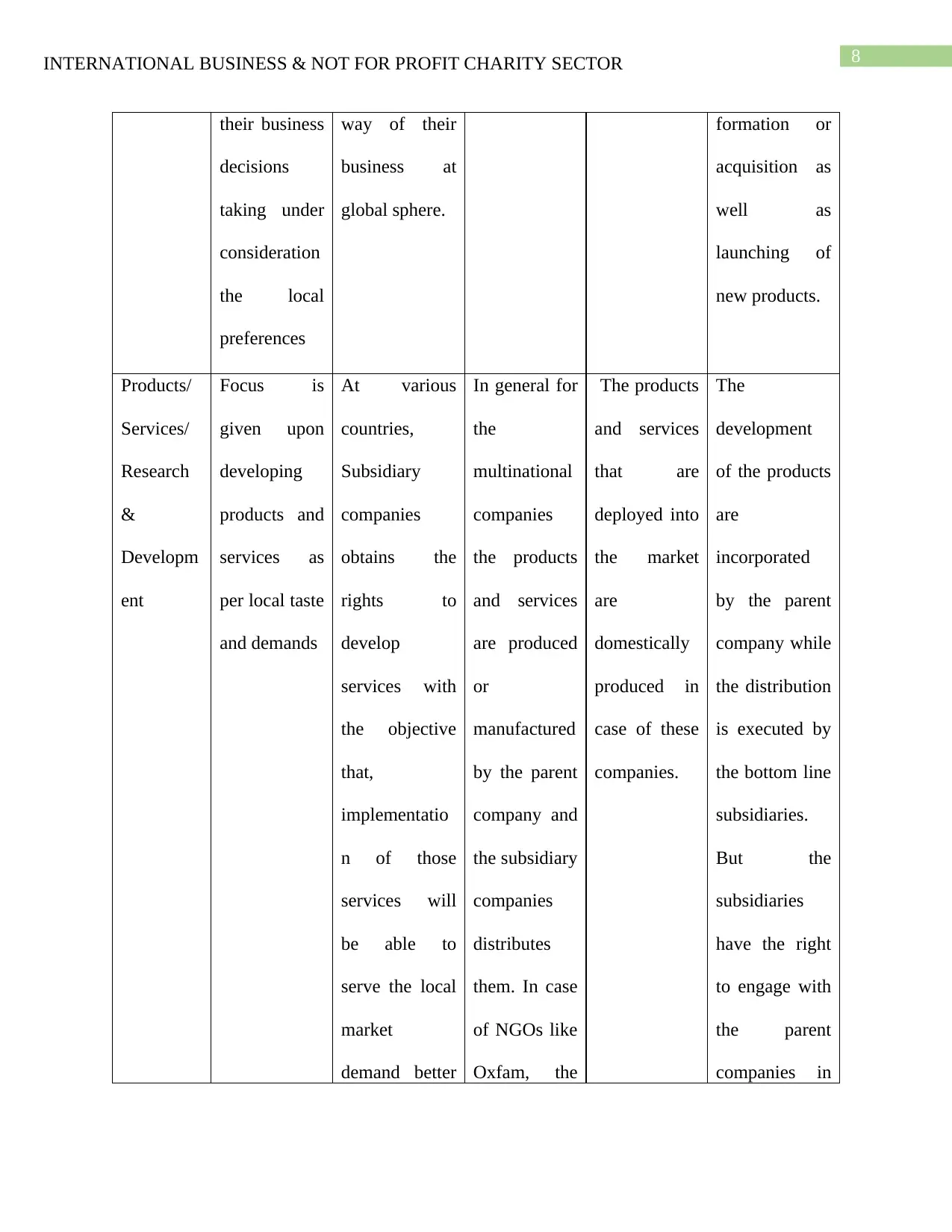
8INTERNATIONAL BUSINESS & NOT FOR PROFIT CHARITY SECTOR
their business
decisions
taking under
consideration
the local
preferences
way of their
business at
global sphere.
formation or
acquisition as
well as
launching of
new products.
Products/
Services/
Research
&
Developm
ent
Focus is
given upon
developing
products and
services as
per local taste
and demands
At various
countries,
Subsidiary
companies
obtains the
rights to
develop
services with
the objective
that,
implementatio
n of those
services will
be able to
serve the local
market
demand better
In general for
the
multinational
companies
the products
and services
are produced
or
manufactured
by the parent
company and
the subsidiary
companies
distributes
them. In case
of NGOs like
Oxfam, the
The products
and services
that are
deployed into
the market
are
domestically
produced in
case of these
companies.
The
development
of the products
are
incorporated
by the parent
company while
the distribution
is executed by
the bottom line
subsidiaries.
But the
subsidiaries
have the right
to engage with
the parent
companies in
their business
decisions
taking under
consideration
the local
preferences
way of their
business at
global sphere.
formation or
acquisition as
well as
launching of
new products.
Products/
Services/
Research
&
Developm
ent
Focus is
given upon
developing
products and
services as
per local taste
and demands
At various
countries,
Subsidiary
companies
obtains the
rights to
develop
services with
the objective
that,
implementatio
n of those
services will
be able to
serve the local
market
demand better
In general for
the
multinational
companies
the products
and services
are produced
or
manufactured
by the parent
company and
the subsidiary
companies
distributes
them. In case
of NGOs like
Oxfam, the
The products
and services
that are
deployed into
the market
are
domestically
produced in
case of these
companies.
The
development
of the products
are
incorporated
by the parent
company while
the distribution
is executed by
the bottom line
subsidiaries.
But the
subsidiaries
have the right
to engage with
the parent
companies in
⊘ This is a preview!⊘
Do you want full access?
Subscribe today to unlock all pages.

Trusted by 1+ million students worldwide
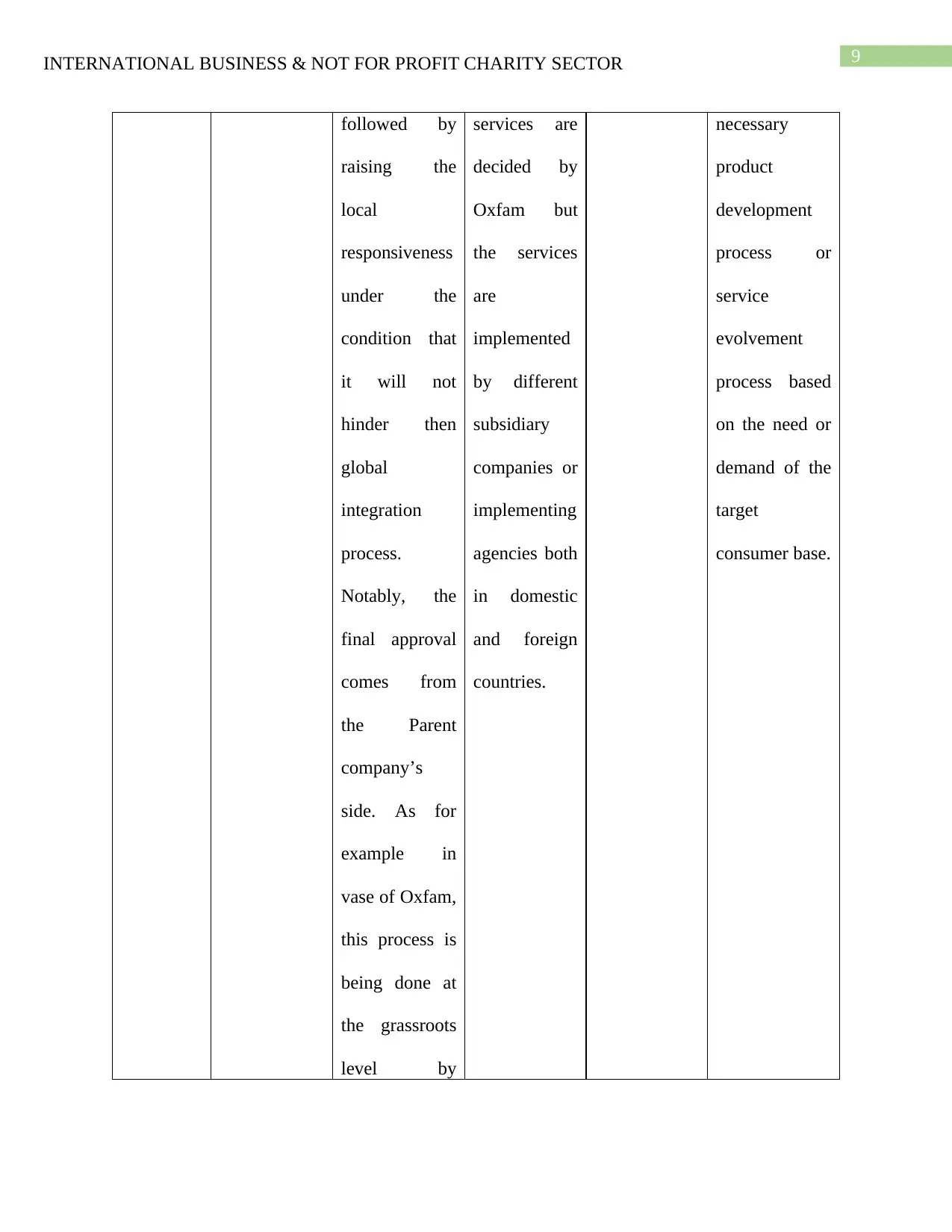
9INTERNATIONAL BUSINESS & NOT FOR PROFIT CHARITY SECTOR
followed by
raising the
local
responsiveness
under the
condition that
it will not
hinder then
global
integration
process.
Notably, the
final approval
comes from
the Parent
company’s
side. As for
example in
vase of Oxfam,
this process is
being done at
the grassroots
level by
services are
decided by
Oxfam but
the services
are
implemented
by different
subsidiary
companies or
implementing
agencies both
in domestic
and foreign
countries.
necessary
product
development
process or
service
evolvement
process based
on the need or
demand of the
target
consumer base.
followed by
raising the
local
responsiveness
under the
condition that
it will not
hinder then
global
integration
process.
Notably, the
final approval
comes from
the Parent
company’s
side. As for
example in
vase of Oxfam,
this process is
being done at
the grassroots
level by
services are
decided by
Oxfam but
the services
are
implemented
by different
subsidiary
companies or
implementing
agencies both
in domestic
and foreign
countries.
necessary
product
development
process or
service
evolvement
process based
on the need or
demand of the
target
consumer base.
Paraphrase This Document
Need a fresh take? Get an instant paraphrase of this document with our AI Paraphraser

10INTERNATIONAL BUSINESS & NOT FOR PROFIT CHARITY SECTOR
different
implementatio
n agencies.
The
implementatio
n agencies
launches their
services after
approval from
Oxfam.
Challenge
s
Varied
culture and
organizationa
l structure
leads towards
confrontation
with
problems of
manpower
issues
Due to
different
demographic
location and
varied cultural
framework in
different
countries it is
been observed
that the gap
between the
subsidiary
implementatio
The
important
challenge that
this
companies
face is related
to legal
issues that
are majorly
regarding
IPR
(Intellectual
Property
Regulatory
issues,
custom and
legal issues
are the major
bottlenecks
of these
companies
due to the
fact that in
case of some
of the
companies it
These
companies
misses the
local touch
sometimes for
which the
demand for
their
commodities
and services
gets lowered in
few of the
companies.
different
implementatio
n agencies.
The
implementatio
n agencies
launches their
services after
approval from
Oxfam.
Challenge
s
Varied
culture and
organizationa
l structure
leads towards
confrontation
with
problems of
manpower
issues
Due to
different
demographic
location and
varied cultural
framework in
different
countries it is
been observed
that the gap
between the
subsidiary
implementatio
The
important
challenge that
this
companies
face is related
to legal
issues that
are majorly
regarding
IPR
(Intellectual
Property
Regulatory
issues,
custom and
legal issues
are the major
bottlenecks
of these
companies
due to the
fact that in
case of some
of the
companies it
These
companies
misses the
local touch
sometimes for
which the
demand for
their
commodities
and services
gets lowered in
few of the
companies.
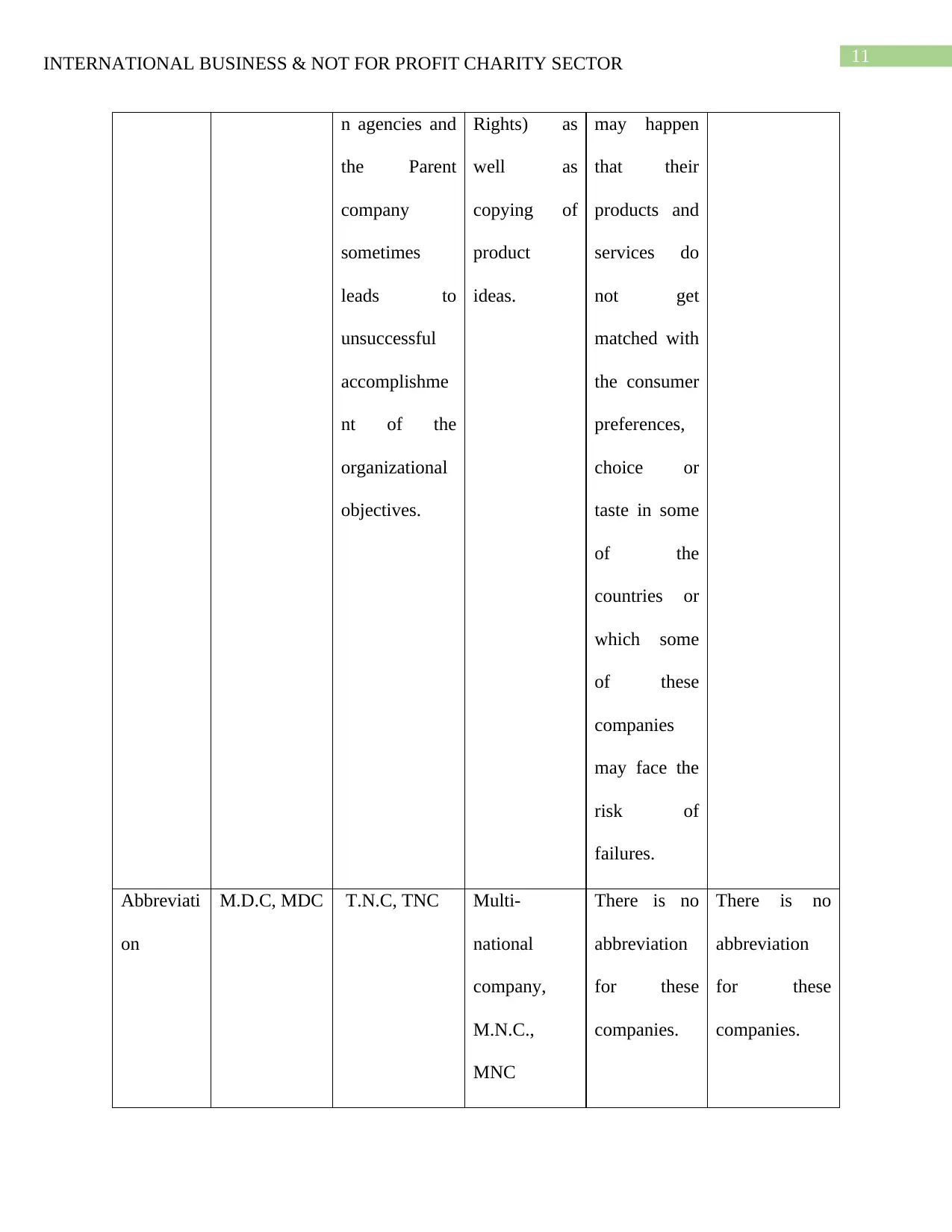
11INTERNATIONAL BUSINESS & NOT FOR PROFIT CHARITY SECTOR
n agencies and
the Parent
company
sometimes
leads to
unsuccessful
accomplishme
nt of the
organizational
objectives.
Rights) as
well as
copying of
product
ideas.
may happen
that their
products and
services do
not get
matched with
the consumer
preferences,
choice or
taste in some
of the
countries or
which some
of these
companies
may face the
risk of
failures.
Abbreviati
on
M.D.C, MDC T.N.C, TNC Multi-
national
company,
M.N.C.,
MNC
There is no
abbreviation
for these
companies.
There is no
abbreviation
for these
companies.
n agencies and
the Parent
company
sometimes
leads to
unsuccessful
accomplishme
nt of the
organizational
objectives.
Rights) as
well as
copying of
product
ideas.
may happen
that their
products and
services do
not get
matched with
the consumer
preferences,
choice or
taste in some
of the
countries or
which some
of these
companies
may face the
risk of
failures.
Abbreviati
on
M.D.C, MDC T.N.C, TNC Multi-
national
company,
M.N.C.,
MNC
There is no
abbreviation
for these
companies.
There is no
abbreviation
for these
companies.
⊘ This is a preview!⊘
Do you want full access?
Subscribe today to unlock all pages.

Trusted by 1+ million students worldwide
1 out of 24
Related Documents
Your All-in-One AI-Powered Toolkit for Academic Success.
+13062052269
info@desklib.com
Available 24*7 on WhatsApp / Email
![[object Object]](/_next/static/media/star-bottom.7253800d.svg)
Unlock your academic potential
Copyright © 2020–2025 A2Z Services. All Rights Reserved. Developed and managed by ZUCOL.



